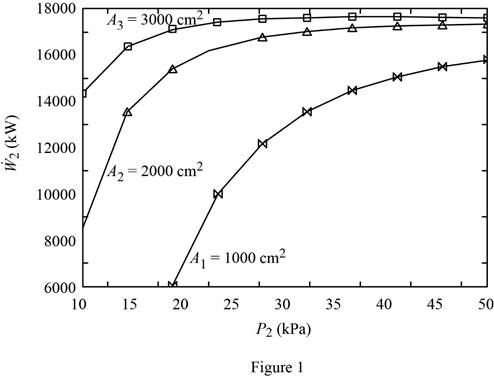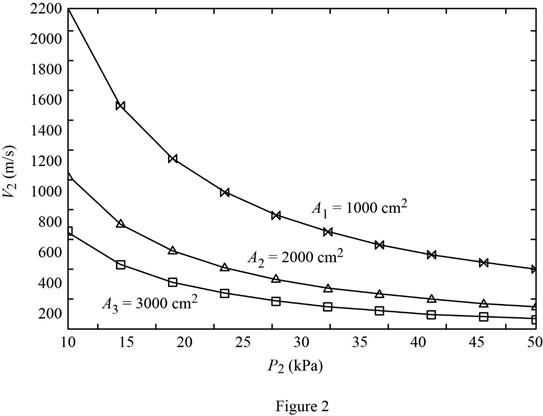
Concept explainers
Reconsider Prob. 5–178. Using appropriate software, investigate the effects of turbine exit area and turbine exit pressure on the exit velocity and power output of the turbine. Let the exit pressure vary from 10 to 50 kPa (with the same quality), and let the exit area vary from 1000 to 3000 cm2. Plot the exit velocity and the power outlet against the exit pressure for the exit areas of 1000, 2000, and 3000 cm2, and discuss the
results.
5–178 Steam enters a turbine steadily at 7 MPa and 600°C with a velocity of 60 m/s and leaves at 25 kPa with a quality of 95 percent. A heat loss of 20 kJ/kg occurs during the process. The inlet area of the turbine is 150 cm2, and the exit area is 1400 cm2. Determine (a) the mass flow rate of the steam, (b) the exit velocity, and (c) the power output.
Plot the exit pressure against power output of turbine and exit pressure against exit velocity for varying pressure from
Answer to Problem 179RP
The plot for the exit pressure against power output of turbine and exit pressure against exit velocity for varying pressure from
Explanation of Solution
The turbine operates steadily. Hence, the inlet and exit mass flow rates are equal.
Write the formula for inlet mass flow rate.
Here, the cross-sectional area is
At inlet:
The steam is at the state of superheated condition.
Refer Table A-6, “Superheated water”.
Obtain the inlet enthalpy
The turbine operates steadily. Hence, the inlet and exit mass flow rates are equal.
Write the formula for exit mass flow rate.
Here, the cross-sectional area is
Rearrange the Equation (II) to obtain exit velocity
At exit:
Consider the exit pressure
The steam is with the quality of
Write the formula for exit enthalpy
Write the formula for exit specific volume
Here, the enthalpy is
Refer Table A-5, “Saturated water—Pressure table”.
Obtain the following corresponding to the pressure of
Consider the steam flows at steady state. Hence, the inlet and exit mass flow rates are equal.
Write the energy rate balance equation for one inlet and one outlet system.
Here, the rate of heat transfer is
The refrigerant flows at steady state through the compressor. Hence, the rate of change in net energy of the system becomes zero.
Heat loss occurs at the rate of
The Equations (VI) reduced as follows to obtain the work output
Here,
Rewrite the Equation (VII) as follows.
Conclusion:
Substitute
Substitute
Equation (V).
Substitute
Consider the exit area
Substitute
Equation (III).
Substitute
The exit velocity
Using excel spread sheet, the exit velocity
| S.No. | |||
| 1 | 10 | 2253.540216 | –22171.1196 |
| 2 | 15 | 1539.230498 | –514.857057 |
| 3 | 20 | 1174.871104 | 7295.806083 |
| 4 | 25 | 952.9435377 | 10965.91684 |
| 5 | 30 | 803.2150134 | 12968.62817 |
| 6 | 40 | 613.4390747 | 14943.44488 |
| 7 | 50 | 497.7670121 | 15822.49054 |
Table 1
Similarly, the exit velocity
| S.No. | |||
| 1 | 10 | 1126.770108 | 8623.292217 |
| 2 | 15 | 769.6152491 | 13851.56455 |
| 3 | 20 | 587.435552 | 15665.73428 |
| 4 | 25 | 476.4717689 | 16472.41662 |
| 5 | 30 | 401.6075067 | 16880.6829 |
| 6 | 40 | 306.7195374 | 17225.27947 |
| 7 | 50 | 248.883506 | 17324.918 |
Table 2
Similarly, the exit velocity
| S.No. | |||
| 1 | 10 | 751.180072 | 14325.96107 |
| 2 | 15 | 513.0768327 | 16512.01299 |
| 3 | 20 | 391.6237013 | 17215.72099 |
| 4 | 25 | 317.6478459 | 17492.1388 |
| 5 | 30 | 267.7383378 | 17605.13749 |
| 6 | 40 | 204.4796916 | 17647.84143 |
| 7 | 50 | 165.9223374 | 17603.1453 |
Table 3
Refer Table 1, 2, and 3.
Plot the graph for the exit pressure

Refer Table 1, 2, and 3.
Plot the graph for the exit pressure

Want to see more full solutions like this?
Chapter 5 Solutions
Thermodynamics: An Engineering Approach
Additional Engineering Textbook Solutions
Vector Mechanics For Engineers
Mechanics of Materials (10th Edition)
BASIC BIOMECHANICS
Database Concepts (8th Edition)
Electric Circuits. (11th Edition)
Thermodynamics: An Engineering Approach
- I need handwritten solution with sketches for eacharrow_forwardGiven answers to be: i) 14.65 kN; 6.16 kN; 8.46 kN ii) 8.63 kN; 9.88 kN iii) Bearing 6315 for B1 & B2, or Bearing 6215 for B1arrow_forward(b) A steel 'hot rolled structural hollow section' column of length 5.75 m, has the cross-section shown in Figure Q.5(b) and supports a load of 750 kN. During service, it is subjected to axial compression loading where one end of the column is effectively restrained in position and direction (fixed) and the other is effectively held in position but not in direction (pinned). i) Given that the steel has a design strength of 275 MN/m², determine the load factor for the structural member based upon the BS5950 design approach using Datasheet Q.5(b). [11] ii) Determine the axial load that can be supported by the column using the Rankine-Gordon formula, given that the yield strength of the material is 280 MN/m² and the constant *a* is 1/30000. [6] 300 600 2-300 mm wide x 5 mm thick plates. Figure Q.5(b) L=5.75m Pinned Fixedarrow_forward
- Q1: For the following force system, find the moments with respect to axes x, y, and zarrow_forwardQ10) Body A weighs 600 lb contact with smooth surfaces at D and E. Determine the tension in the cord and the forces acting on C on member BD, also calculate the reaction at B and F. Cable 6' 3' wwwarrow_forwardHelp ارجو مساعدتي في حل هذا السؤالarrow_forward
- Q3: Find the resultant of the force system.arrow_forwardQuestion 1 A three-blade propeller of a diameter of 2 m has an activity factor AF of 200 and its ratio of static thrust coefficient to static torque coefficient is 10. The propeller's integrated lift coefficient is 0.3.arrow_forward(L=6847 mm, q = 5331 N/mm, M = 1408549 N.mm, and El = 8.6 x 1014 N. mm²) X A ΕΙ B L Y Marrow_forward
 Elements Of ElectromagneticsMechanical EngineeringISBN:9780190698614Author:Sadiku, Matthew N. O.Publisher:Oxford University Press
Elements Of ElectromagneticsMechanical EngineeringISBN:9780190698614Author:Sadiku, Matthew N. O.Publisher:Oxford University Press Mechanics of Materials (10th Edition)Mechanical EngineeringISBN:9780134319650Author:Russell C. HibbelerPublisher:PEARSON
Mechanics of Materials (10th Edition)Mechanical EngineeringISBN:9780134319650Author:Russell C. HibbelerPublisher:PEARSON Thermodynamics: An Engineering ApproachMechanical EngineeringISBN:9781259822674Author:Yunus A. Cengel Dr., Michael A. BolesPublisher:McGraw-Hill Education
Thermodynamics: An Engineering ApproachMechanical EngineeringISBN:9781259822674Author:Yunus A. Cengel Dr., Michael A. BolesPublisher:McGraw-Hill Education Control Systems EngineeringMechanical EngineeringISBN:9781118170519Author:Norman S. NisePublisher:WILEY
Control Systems EngineeringMechanical EngineeringISBN:9781118170519Author:Norman S. NisePublisher:WILEY Mechanics of Materials (MindTap Course List)Mechanical EngineeringISBN:9781337093347Author:Barry J. Goodno, James M. GerePublisher:Cengage Learning
Mechanics of Materials (MindTap Course List)Mechanical EngineeringISBN:9781337093347Author:Barry J. Goodno, James M. GerePublisher:Cengage Learning Engineering Mechanics: StaticsMechanical EngineeringISBN:9781118807330Author:James L. Meriam, L. G. Kraige, J. N. BoltonPublisher:WILEY
Engineering Mechanics: StaticsMechanical EngineeringISBN:9781118807330Author:James L. Meriam, L. G. Kraige, J. N. BoltonPublisher:WILEY





